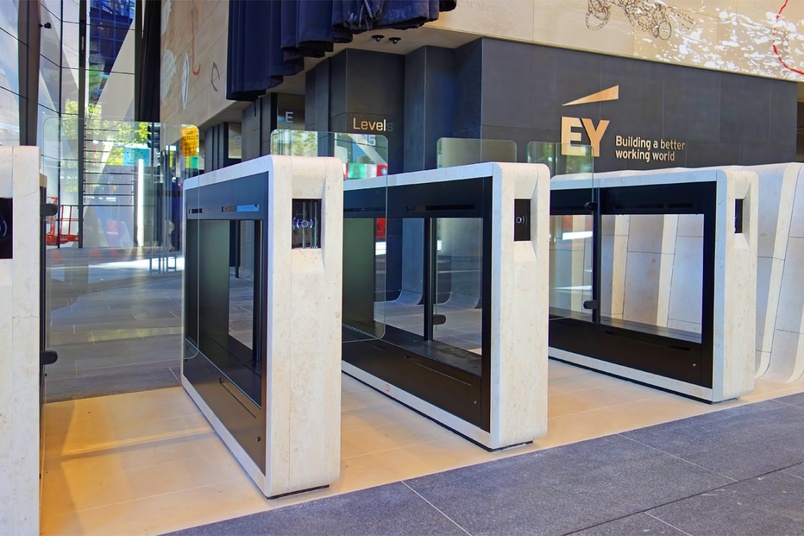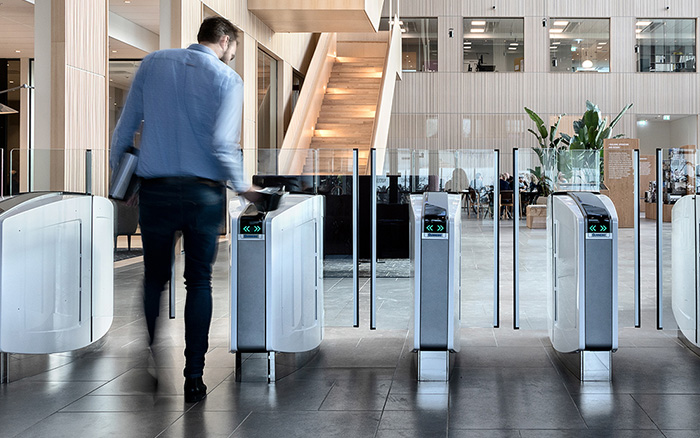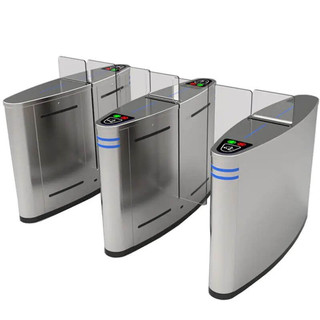- Home
- About Us
- Products
- Electronic Article Surveillance System EAS / Retail Anti theft Systems
- Display Stands
- Restaurant Pager
- People Counting Systems
- Queue Management Systems
- Access Control System
- Time Attendance Systems
- Audio & Visual System Solutions
- Display Solutions
- CCTV Cameras in Qatar: Enhancing Security Solutions
- Time Lapse Construction Camera
- Flap Barrier, Speed Gates, Turnstiles Access Control
- Gate Barriers System & Bollards in Qatar
- Parking Management & Gate Automation
- Library Management Systems
- IT & Telecom
- Lockers & Key Management Systems
- Intrusion Alarm System
- Perimeter Security
- Vehicle Tracking
- Time Recorders & Time Stamps
- Emergency Exit Door Alarms
- Clients
- Contact Us
- Support
Contents
- 1 Flap Barrier Dimensions: A Comprehensive Guide by Axle Systems
- 1.0.1 What Are Flap Barrier Dimensions?
- 1.0.2 How Do Flap Barrier Dimensions Work?
- 1.0.3 The Benefits of Flap Barrier Dimensions:
- 1.0.4 Community Engagement and Corporate Social Responsibility:
- 1.0.5 Understanding the Local Context in Qatar:
- 1.0.6 The Best Way to Utilize Flap Barrier Dimensions:
- 1.0.7 Best Practices for Using Flap Barrier Dimensions:
- 1.0.8 Implementing Flap Barrier Dimensions: Tips and Considerations:
- 1.0.9 Maximizing Benefits of Flap Barrier Dimensions:
- 1.0.10 Maintaining Flap Barrier Systems for Long-Term Reliability:
- 1.0.11 Common Misconceptions About Flap Barrier Dimensions:
- 1.0.12 Looking Ahead: The Future of Flap Barrier Technology:
- 1.0.13 Contact Axle Systems for Flap Barrier Dimensions in Qatar:
- 1.0.14 Common FAQs about Flap Barrier Dimensions:
- 1.0.15 In Conclusion:
Flap Barrier Dimensions: A Comprehensive Guide by Axle Systems
Introduction:
Flap barriers have become an integral part of modern security systems, providing a robust solution for controlled access in various environments. In this blog post, we’ll delve into the world of flap barrier dimensions, exploring what they are, how they work, their benefits, and the best practices for utilizing them effectively. If you’re in Qatar and looking for a reliable distributor of flap barrier dimensions, look no further than Axle Systems. Let’s get started!
What Are Flap Barrier Dimensions?
Flap barrier dimensions refer to the physical measurements of the flap barriers used in access control systems. These dimensions play a crucial role in determining the suitability of flap barriers for specific spaces. Typically, flap barriers come in various sizes, and understanding their dimensions is essential for seamless integration into diverse environments.
How Do Flap Barrier Dimensions Work?
Flap barriers are designed with precision, taking into account the space available and the level of security required. The dimensions of flap barriers involve the height, width, and depth of the unit. The mechanism relies on a motor-driven system that controls the movement of the barrier arms. The arms are usually constructed to match the dimensions of the entry point, allowing for a secure and controlled passage.
The Benefits of Flap Barrier Dimensions:
- Space Optimization: Flap barriers are known for their space-efficient design, making them suitable for areas with limited space. The dimensions can be customized to fit specific entry points, ensuring optimal utilization of available space.
- Enhanced Security: The precise dimensions of flap barriers contribute to their effectiveness in controlling access. The barriers create a physical barrier that prevents unauthorized entry, enhancing the overall security of the premises.
- User-Friendly Design: Flap barriers with well-defined dimensions offer a user-friendly experience. They can be seamlessly integrated into existing infrastructure without causing disruptions to the flow of people.
- Customization Options: Businesses and organizations can benefit from the flexibility of choosing flap barrier dimensions that align with their unique requirements. This customization ensures a tailored solution that meets specific security needs.
In addition to their fundamental dimensions, modern flap barriers come equipped with advanced features that further enhance their functionality and security. Some notable features include:
- Biometric Integration: Many flap barriers now support biometric authentication, such as fingerprint or facial recognition. This additional layer of security ensures that only authorized personnel can access the secured area.
- Infrared Sensors: Flap barriers are often equipped with infrared sensors that detect the presence of individuals. This not only improves user experience by providing hands-free access but also contributes to the overall safety of the system.
- Anti-Tailgating Technology: Flap barriers can be configured with anti-tailgating technology, preventing unauthorized individuals from following closely behind an authorized user. This feature adds an extra level of security by ensuring only one person can pass through for each valid authentication.
- Integration with Visitor Management Systems: To streamline visitor access, flap barriers can be integrated with visitor management systems. This allows for easy registration and tracking of visitors, enhancing overall access control.
- Remote Monitoring and Control: With the advancement of technology, flap barriers can be remotely monitored and controlled. This feature is particularly beneficial for large-scale installations, allowing for centralized management of multiple access points.
Community Engagement and Corporate Social Responsibility:
Training Programs:
- Axle Systems actively engages in community training programs to raise awareness about the importance of secure access control.
- By empowering communities with knowledge, Axle Systems contributes to a culture of security and responsible technology use.
Local Employment Initiatives:
- Supporting local employment initiatives is a priority for Axle Systems.
- By fostering local talent and providing employment opportunities, the company contributes to the socioeconomic development of the communities it serves.
Collaboration with Educational Institutions:
- Partnering with educational institutions, Axle Systems facilitates knowledge exchange and research initiatives in the field of access control.
- This collaboration supports the growth of the industry and nurtures future talent.
Understanding the Local Context in Qatar:
In the context of Qatar, where security is a top priority, the deployment of advanced access control systems like flap barriers is crucial. The dimensions of flap barriers need to align with the architectural and security requirements of the region. Axle Systems, as a reputable distributor in Qatar, understands the unique challenges and priorities of businesses and organizations in the area. Their expertise in providing tailored solutions ensures that flap barriers seamlessly integrate into the local security infrastructure.
The Best Way to Utilize Flap Barrier Dimensions:
To make the most of flap barrier dimensions, businesses and organizations should consider the following best practices:
- Collaborative Planning: Engage in collaborative planning with security experts and system integrators to determine the most suitable dimensions for the flap barriers based on the specific needs of your facility.
- User Training: Provide comprehensive training to users and security personnel on the correct use of flap barriers. This includes understanding the dimensions, the authentication process, and emergency procedures.
- Regular System Audits: Conduct regular audits of the access control system, including flap barriers, to identify and address any issues promptly. This proactive approach helps maintain the security and efficiency of the system.
- Stay Informed about Updates: Keep abreast of technological advancements and updates in access control systems. This ensures that your flap barriers are equipped with the latest features and security protocols.
Best Practices for Using Flap Barrier Dimensions:
- Site Assessment: Before installing flap barriers, conduct a thorough site assessment to determine the ideal dimensions. Consider factors such as foot traffic, available space, and security requirements.
- Integration with Access Control Systems: To maximize the effectiveness of flap barriers, integrate them with a comprehensive access control system. This allows for centralized management and monitoring of access points.
- Regular Maintenance: Ensure that flap barriers are regularly maintained to prevent malfunctions. Routine checks and servicing will prolong the lifespan of the system and maintain optimal performance.
- Environmental Considerations: When selecting flap barrier dimensions, it’s crucial to consider the environmental conditions of the installation site. Axle Systems offers flap barriers that are resistant to dust, moisture, and temperature fluctuations, ensuring reliable performance in diverse settings.
- Customization for Aesthetic Integration: Beyond functionality, Axle Systems understands the importance of aesthetic integration. Flap barriers can be customized not only for optimal security but also to blend seamlessly with the Flap barrier dimensions architectural aesthetics of the premises.
- Emergency Egress Features: Flap barriers are equipped with emergency egress features to facilitate quick evacuation in case of emergencies. Understanding these features and incorporating them into your emergency response plan is essential for the safety of occupants.
- Energy Efficiency: Axle Systems provides energy-efficient flap barriers, contributing to sustainable building practices. These barriers are designed to conserve energy while maintaining high-performance standards.
Implementing Flap Barrier Dimensions: Tips and Considerations:
As you embark on the journey of implementing flap barrier dimensions for your access control system, it’s essential to consider various factors to ensure a seamless and effective integration. Here are some tips and considerations:
- Comprehensive Site Analysis:
- Conduct a thorough site analysis to identify high-traffic areas, entry points, and any potential bottlenecks.
- Consider the architectural layout and space constraints to determine the most suitable flap barrier dimensions.
- User Authentication Methods:
- Evaluate the various authentication methods supported by flap barriers, such as RFID cards, biometrics, or PIN codes.
- Choose a method or a combination of methods based on the security requirements and user convenience.
- Integration with Access Control Software:
- Ensure that the chosen flap barriers seamlessly integrate with your existing or planned access control software.
- Integration allows for centralized management, real-time monitoring, and easy customization of access permissions.
- User Training and Communication:
- Provide comprehensive training to users on how to use the flap barriers correctly.
- Implement clear and concise communication regarding access policies, emergency procedures, and any system-specific guidelines.Flap barrier dimensions
- Regular System Testing:
- Conduct regular testing of the flap barrier system to identify and address any potential issues promptly.
- Test different scenarios, including peak usage times, to ensure the system’s reliability under various conditions.
- Scalability:
- Consider the scalability of the chosen flap barrier system. Ensure that it can accommodate future expansions or modifications to the access control infrastructure.
- Compliance with Local Regulations:
- Familiarize yourself with local regulations and standards related to access control systems.
- Ensure that the chosen flap barrier dimensions comply with all relevant safety and security guidelines.
Maximizing Benefits of Flap Barrier Dimensions:
- Optimized Traffic Flow:
- Strategically position flap barriers to optimize the flow of pedestrian traffic.
- Consider additional lanes for peak hours to prevent congestion during busy periods.
- Data Analytics for Improved Security:
- Leverage the data generated by flap barriers for analytics purposes.
- Analyze user patterns, identify potential security risks, and enhance overall system efficiency.
- Regular Maintenance and Software Updates:
- Establish a routine maintenance schedule to keep flap barriers in optimal condition.
- Stay informed about software updates and security patches to ensure the latest features and enhancements.
- Collaboration with Security Professionals:
- Work closely with security professionals and system integrators throughout the implementation process.
- Seek their expertise in optimizing flap barrier dimensions for enhanced security.
- Continuous Monitoring and Reporting:
- Implement a robust monitoring system to detect and report any anomalies or security breaches.
- Ensure that security personnel receive real-time alerts for prompt response.
Maintaining Flap Barrier Systems for Long-Term Reliability:
Once your flap barrier system is in place, maintaining it becomes crucial for long-term reliability and optimal performance. Implementing a proactive maintenance strategy ensures that your investment continues to deliver secure and efficient access control. Here are key aspects to consider:
- Scheduled Inspections:
- Conduct regular inspections of the entire flap barrier system, including mechanical components, sensors, and control panels.
- Look for signs of wear and tear, corrosion, or any physical damage that may compromise performance.
- Cleaning and Lubrication:
- Keep the flap barriers clean from dirt, dust, and debris that can accumulate over time.
- Lubricate moving parts according to the manufacturer’s recommendations to prevent friction and ensure smooth operation.
- Testing Emergency Features:
- Regularly test the emergency egress features to guarantee a swift and safe evacuation process.
- Ensure that manual release mechanisms are functioning correctly and that the barriers open smoothly during emergency situations.
- Software Updates and Security Patches:
- Stay vigilant about software updates and security patches provided by the flap barrier system manufacturer.
- Implement updates promptly to benefit from new features, performance enhancements, and security fixes.
- User Training Refreshers:
- Periodically refresh user training to ensure that both security personnel and end-users are well-acquainted with the system.
- Communicate any changes in access policies, emergency procedures, or system functionalities.
- Monitoring Analytics Data:
- Analyze the data generated by the flap barrier system to identify trends and potential issues.
- Use analytics to make informed decisions about system optimization and security improvements.
Common Misconceptions About Flap Barrier Dimensions:
- One-Size-Fits-All: Flap barriers are not one-size-fits-all solutions. It’s a common misconception that any flap barrier will do for any space. Customization based on dimensions and features is essential for effective deployment.
- Limited Application: Some believe that flap barriers are only suitable for certain types of buildings or industries. In reality, the versatility of flap barriers allows them to be implemented across various sectors, from corporate offices to industrial facilities.
- Maintenance-Free Operation: While flap barriers are designed for durability, they are not maintenance-free. Regular upkeep is necessary to ensure consistent performance and longevity.
Looking Ahead: The Future of Flap Barrier Technology:
As technology continues to evolve, so does the landscape of access control systems. The future of flap barrier technology holds exciting possibilities, including:
- Biometric Advancements: Further integration of advanced biometric technologies for even more secure and convenient access.
- Artificial Intelligence (AI) Integration: AI-driven features to enhance threat detection, adaptive access control, and predictive maintenance.
- Enhanced Connectivity: Improved connectivity for seamless integration with smart building systems, IoT devices, and centralized security platforms.
- Augmented Reality (AR) Interfaces: Innovative AR interfaces for user guidance and enhanced user experience during the authentication process.
Contact Axle Systems for Flap Barrier Dimensions in Qatar:
If you are in Qatar and seeking a reliable distributor for flap barrier dimensions, Axle Systems is your go-to solution. Contact them at +974 44682391 or via email at [email protected] to discuss your specific requirements. Axle Systems is committed to providing top-notch security solutions tailored to your needs.
Common FAQs about Flap Barrier Dimensions:
Q1: What are the standard dimensions of flap barriers?
A1: Flap barriers come in various standard dimensions, and the ideal size depends on the specific requirements of the installation site. Common dimensions include variations in height, width, and depth.
Q2: Can flap barriers be customized to fit unique entry points?
A2: Yes, one of the key benefits of flap barriers is their customization options. They can be tailored to fit unique entry points, ensuring a perfect fit for diverse environments.
Q3: How do flap barriers contribute to security?
A3: Flap barriers enhance security by creating a physical barrier that prevents unauthorized access. Their dimensions are designed to control the flow of individuals, allowing only authorized personnel to pass through.
Q4: What is the recommended maintenance schedule for flap barriers?
A4: It is recommended to perform regular maintenance on flap barriers, including checks on the motor system, sensors, and overall functionality. A routine maintenance schedule helps prevent malfunctions and ensures consistent performance.
Q5: Can flap barriers be integrated with existing security systems?
A5: Yes, flap barriers are designed to be compatible with various security systems, including CCTV cameras, biometric devices, and access control software. Integration enhances overall security and provides a comprehensive solution.
Q6: What is the lifespan of flap barriers, and how often should they be replaced?
A6: The lifespan of flap barriers depends on factors such as usage, maintenance, and environmental conditions. With regular maintenance, flap barriers can last for many years. However, it’s advisable to assess their condition periodically and consider an upgrade if needed.
Q7: Do flap barriers require regular calibration?
A7: Flap barriers may require occasional calibration to ensure precise functionality. Calibration should be carried out by trained technicians to maintain accuracy in detecting and allowing authorized access.
Q8: Are flap barriers suitable for outdoor installations?
A8: While flap barriers are commonly used indoors, some models are designed for outdoor use. These outdoor variants are built to withstand varying weather conditions, providing secure access control in both indoor and outdoor environments.
In Conclusion:
Flap barrier dimensions are not just about the physical measurements; they represent a key element in the broader landscape of access control and security. As technology evolves, so do the capabilities of flap barriers, making them an integral part of contemporary security solutions. For businesses and organizations in Qatar, the partnership with Axle Systems offers a gateway to cutting-edge flap barrier dimensions tailored to meet the highest standards of security. Embrace the future of access control and safeguard your premises with precision and efficiency.
For inquiries and consultation on flap barrier dimensions in Qatar, contact Axle Systems at +974 44682391 or email them at [email protected]. Take the first step towards a secure and controlled access environment with a trusted partner by your side.





